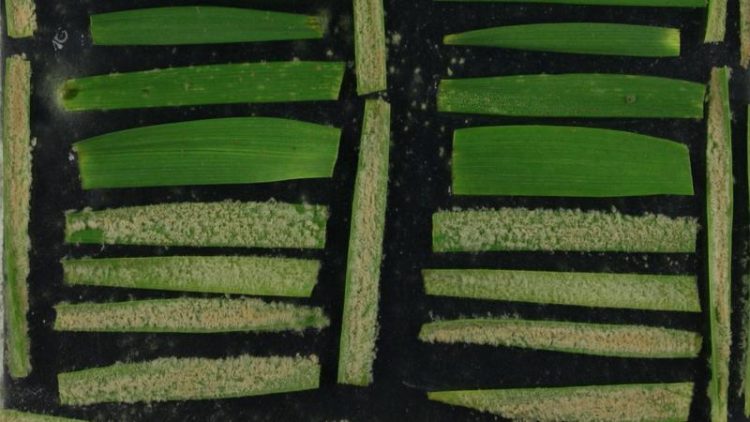Fungus attacks new type of grain thanks to an evolutionary trick

Researchers collected samples from infected grain fields all over Europe. Image: UZH
Triticale is an artificial grain type stemming from a cross between wheat and rye. Since the 1960s, triticale has been cultivated in many places as a feed grain and had proved very resistant to mildew attack. This fungal pathogen causes huge losses in cereal production.
In the case of wheat, for example, the fungus can reduce the harvest by up to 45%. But triticale fields were infected for the first time in 2001, and mildew is now being reported in many triticale growing regions in Europe.
Comparison of the mildew genome confirms: The new form is a hybrid
Researchers from the University of Zurich have now examined how the mildew managed to spread to triticale. To do this, they collected samples from infected grain fields all over Europe and examined the genetic information of different forms of mildew.
The genetic material (genome) of the pathogens that attack triticale, rye and wheat were then compared using bioinformatics. The comparisons showed that the new triticale fungus is a hybrid of the variants specialized in wheat and rye: 12.5% of the genome is identical to DNA sequences from the form specialized in rye, while 87.5% stems from the form specialized in wheat.
Evolution of the pathogen reflects the development of the host plant
This means that a hybrid from two mildew variants specialized in two different host plants can infect the cross between those two host plants. The study thus shows the manner in which mildew adapts to new host plants in a co-evolutionary way and can break down their resistance. The study also reveals that this recent evolutionary event was not a one-off occurrence.
Around 10,000 years ago, mildew overcame the resistance of bread wheat, which was relatively new at the time, in the same way. “These results are of major significance for treating and preventing plant diseases. The more we know about the evolutionary mechanisms of mildew, the better we can keep new cultivated plants resistant to the pathogens”, explains Thomas Wicker from the Institute of Plant Biology at the University of Zurich.
Literature:
Fabrizio Menardo, Coraline R Praz, Stefan Wyder, Roi Ben-David, Salim Bourras, Hiromi Matsumae, Kaitlin E McNally, Francis Parlange, Andrea Riba, Stefan Roffler, Luisa K Schaefer, Kentaro K Shimizu, Luca Valenti, Helen Zbinden, Thomas Wicker & Beat Keller. Hybridization of powdery mildew strains gives raise to pathogens on novel agricultural crop species. Nature Genetics, 11 January 2016.
Doi: 10.1038/ng.3485.
University Research Priority Program “Evolution in action”
This research project was carried out as part of the University Research Priority Program (URPP) “Evolution in action”. The University Research Priority Program “Evolution in action” examines evolutionary mechanisms using state-of-the-art methods from genomics and bioinformatics. Researchers from eight institutes and three faculties at the University of Zurich are involved in the projects of the URPP “Evolution in action”.
http://www.mediadesk.uzh.ch/articles/2015/pilz-befaellt-neue-getreideart-dank-ev…
Media Contact
All latest news from the category: Life Sciences and Chemistry
Articles and reports from the Life Sciences and chemistry area deal with applied and basic research into modern biology, chemistry and human medicine.
Valuable information can be found on a range of life sciences fields including bacteriology, biochemistry, bionics, bioinformatics, biophysics, biotechnology, genetics, geobotany, human biology, marine biology, microbiology, molecular biology, cellular biology, zoology, bioinorganic chemistry, microchemistry and environmental chemistry.
Newest articles

First-of-its-kind study uses remote sensing to monitor plastic debris in rivers and lakes
Remote sensing creates a cost-effective solution to monitoring plastic pollution. A first-of-its-kind study from researchers at the University of Minnesota Twin Cities shows how remote sensing can help monitor and…

Laser-based artificial neuron mimics nerve cell functions at lightning speed
With a processing speed a billion times faster than nature, chip-based laser neuron could help advance AI tasks such as pattern recognition and sequence prediction. Researchers have developed a laser-based…

Optimising the processing of plastic waste
Just one look in the yellow bin reveals a colourful jumble of different types of plastic. However, the purer and more uniform plastic waste is, the easier it is to…



